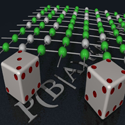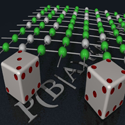Guessing the answer at the beginning
Algorithms and computational tools for making direct first-principles predictions of materials properties have greatly advanced, but they are still mostly limited to handling a few hundred atoms. The problem is particularly challenging for materials that do not have a well-defined periodicity, such as alloys. In these cases, a common technique is the cluster expansion method, which uses the properties of smaller-size clusters to describe the original system. However, even this approach has been generally inefficient for tackling low-symmetry materials such as surfaces or nanoparticles.
The efficiency and accuracy of these calculations can be dramatically improved if the expected properties of the physical solutions are incorporated into the procedure. In a paper appearing in Physical Review B, Tim Mueller and Gerbrand Ceder from MIT in the US have devised a comprehensive framework to efficiently generate cluster expansions with general physical properties built into the algorithm from the very start in a semi-automated fashion. The authors show that their technique is significantly more efficient than commonly used methods of producing cluster expansions and that reliable analysis of low-symmetry systems may finally become manageable. – Ashot Melikyan





